trip computer HYUNDAI TUCSON 2013 Owners Manual
[x] Cancel search | Manufacturer: HYUNDAI, Model Year: 2013, Model line: TUCSON, Model: HYUNDAI TUCSON 2013Pages: 397, PDF Size: 5.55 MB
Page 119 of 397
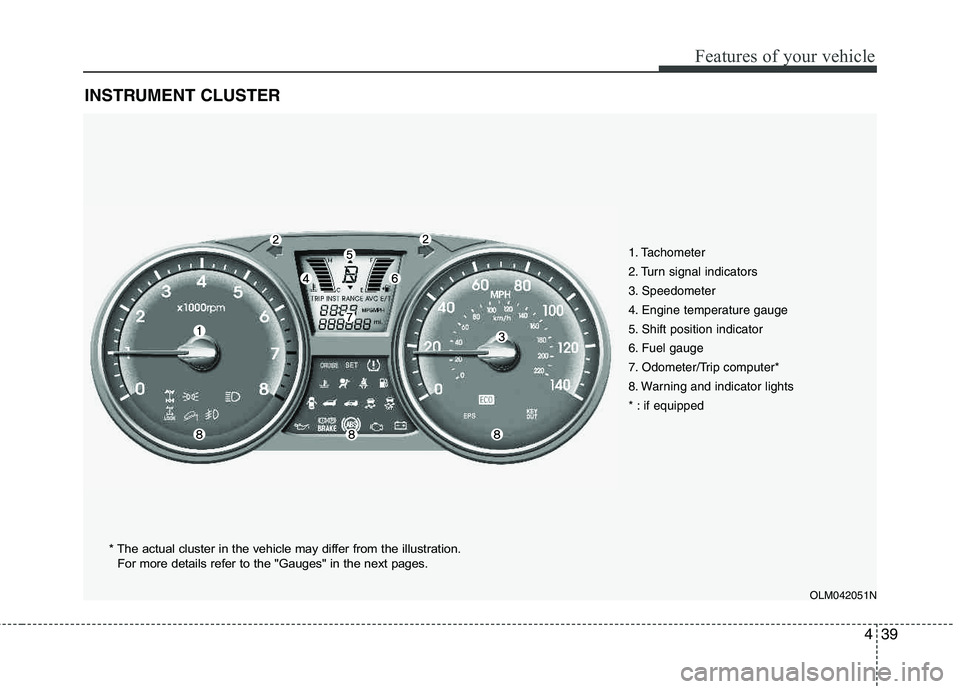
439
Features of your vehicle
INSTRUMENT CLUSTER
1. Tachometer
2. Turn signal indicators
3. Speedometer
4. Engine temperature gauge
5. Shift position indicator
6. Fuel gauge
7. Odometer/Trip computer*
8. Warning and indicator lights
* : if equipped
OLM042051N
* The actual cluster in the vehicle may differ from the illustration.
For more details refer to the "Gauges" in the next pages.
Page 122 of 397
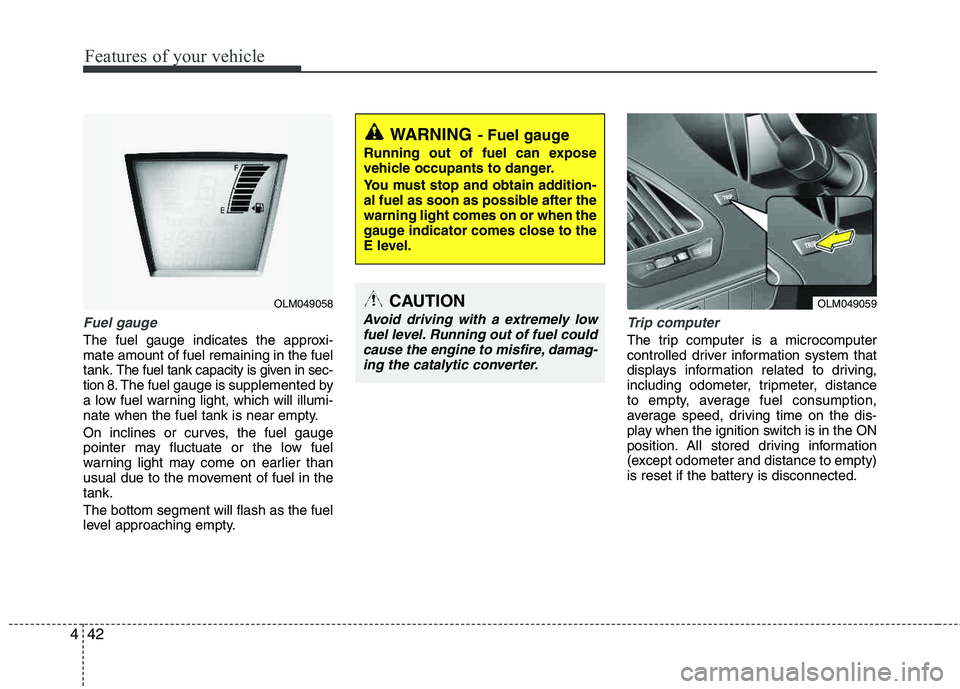
Features of your vehicle
42
4
Fuel gauge
The fuel gauge indicates the approxi- mate amount of fuel remaining in the fueltank.
The fuel tank capacity is given in sec-
tion 8.The fuel gauge is supplemented by
a low fuel warning light, which will illumi-
nate when the fuel tank is near empty.
On inclines or curves, the fuel gauge
pointer may fluctuate or the low fuel
warning light may come on earlier than
usual due to the movement of fuel in the tank. The bottom segment will flash as the fuel
level approaching empty.
Trip computer
The trip computer is a microcomputer
controlled driver information system that
displays information related to driving,
including odometer, tripmeter, distance
to empty, average fuel consumption,
average speed, driving time on the dis-
play when the ignition switch is in the ON
position. All stored driving information
(except odometer and distance to empty)
is reset if the battery is disconnected.
WARNING- Fuel gauge
Running out of fuel can expose
vehicle occupants to danger.
You must stop and obtain addition-
al fuel as soon as possible after the warning light comes on or when the
gauge indicator comes close to the
E level.
CAUTION
Avoid driving with a extremely low
fuel level. Running out of fuel couldcause the engine to misfire, damag- ing the catalytic converter.
OLM049058OLM049059
Page 124 of 397
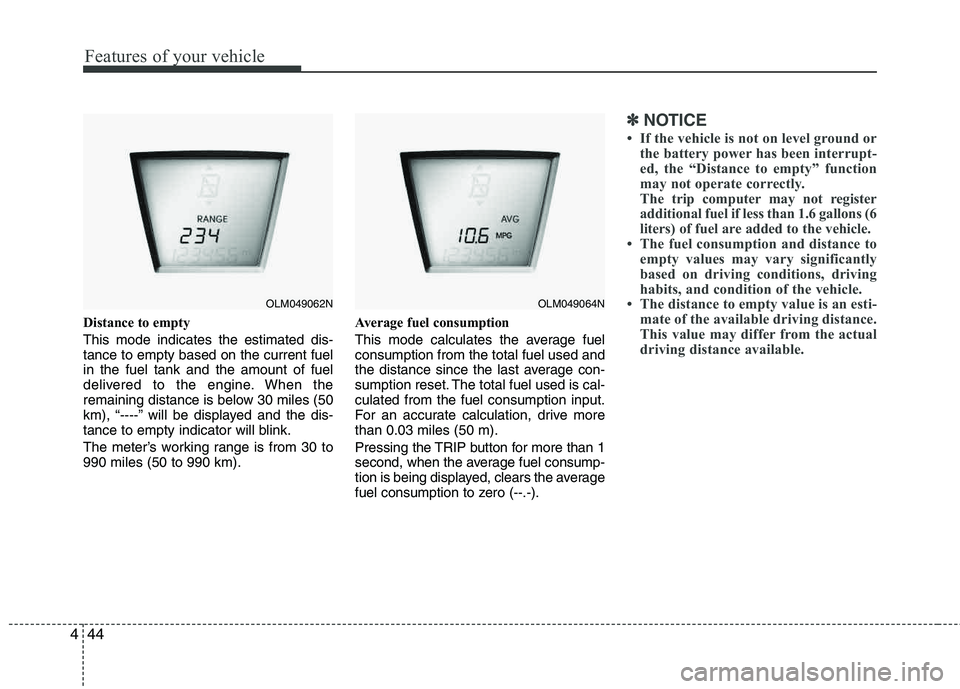
Features of your vehicle
44
4
Distance to empty This mode indicates the estimated dis- tance to empty based on the current fuelin the fuel tank and the amount of fuel
delivered to the engine. When the
remaining distance is below 30 miles (50
km), “----” will be displayed and the dis-
tance to empty indicator will blink.
The meter’s working range is from 30 to 990 miles (50 to 990 km). Average fuel consumption
This mode calculates the average fuel consumption from the total fuel used and
the distance since the last average con-
sumption reset. The total fuel used is cal-culated from the fuel consumption input.
For an accurate calculation, drive more than 0.03 miles (50 m).
Pressing the TRIP button for more than 1
second, when the average fuel consump-
tion is being displayed, clears the average
fuel consumption to zero (--.-).
✽✽
NOTICE
If the vehicle is not on level ground or the battery power has been interrupt-
ed, the “Distance to empty” function
may not operate correctly.
The trip computer may not register
additional fuel if less than 1.6 gallons (6
liters) of fuel are added to the vehicle.
The fuel consumption and distance to empty values may vary significantly
based on driving conditions, driving
habits, and condition of the vehicle.
The distance to empty value is an esti-
mate of the available driving distance.
This value may differ from the actual
driving distance available.
OLM049062NOLM049064N
Page 336 of 397
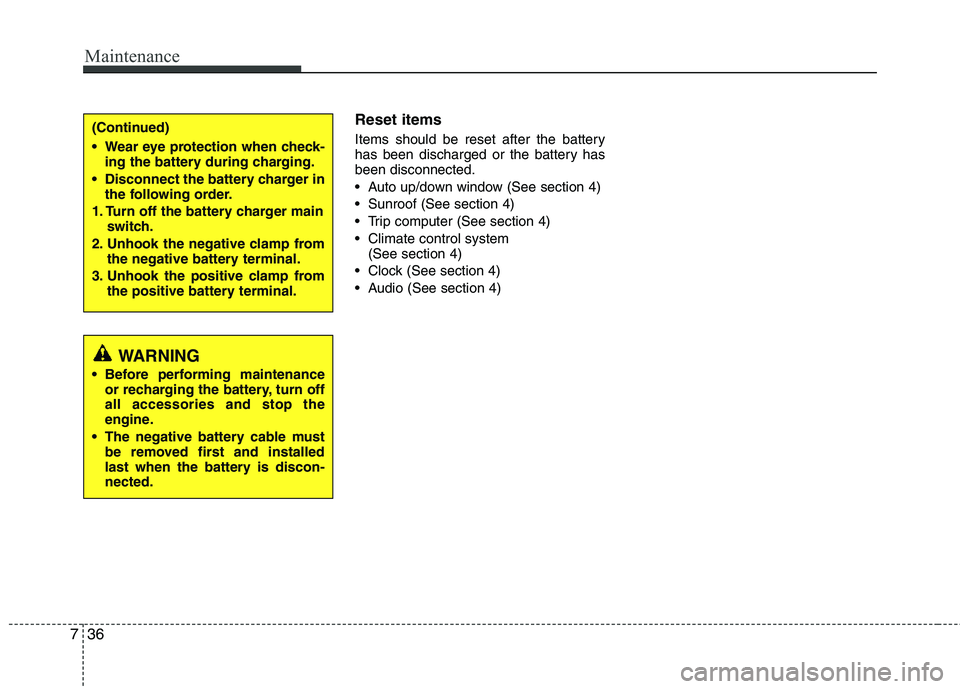
Maintenance
36
7
Reset items
Items should be reset after the battery
has been discharged or the battery has been disconnected.
Auto up/down window (See section 4)
Sunroof (See section 4)
Trip computer (See section 4)
Climate control system
(See section 4)
Clock (See section 4)
Audio (See section 4)(Continued)
Wear eye protection when check- ing the battery during charging.
Disconnect the battery charger in the following order.
1. Turn off the battery charger main switch.
2. Unhook the negative clamp from the negative battery terminal.
3. Unhook the positive clamp from the positive battery terminal.
WARNING
Before performing maintenance or recharging the battery, turn off all accessories and stop the
engine.
The negative battery cable must be removed first and installed
last when the battery is discon-nected.
Page 389 of 397
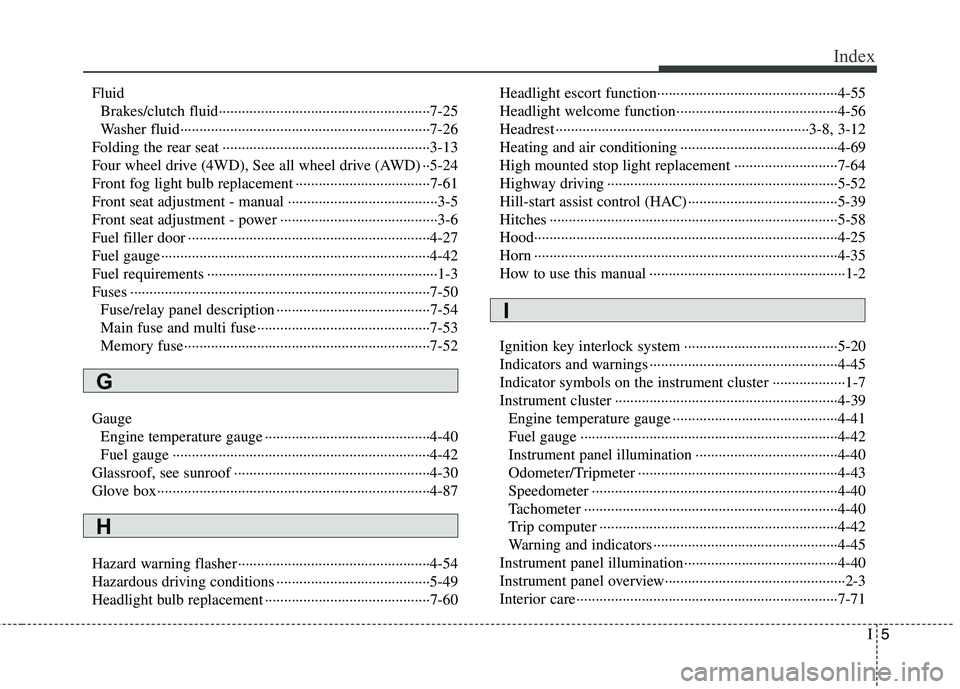
I5
Index
Fluid Brakes/clutch fluid·······················································7-25
Washer fluid·································································7-26
Folding the rear seat ······················································3-13
Four wheel drive (4WD), See all wheel drive (AWD) ··5-24
Front fog light bulb replacement ···································7-61
Front seat adjustment - manual ·······································3-5
Front seat adjustment - power ·········································3-6
Fuel filler door ·······························································4-27
Fuel gauge······································································4-42
Fuel requirements ····························································1-3
Fuses ··············································································7-50 Fuse/relay panel description ········································7-54
Main fuse and multi fuse ·············································7-53
Memory fuse································································7-52
Gauge Engine temperature gauge ···········································4-40
Fuel gauge ···································································4-42
Glassroof, see sunroof ···················································4-30
Glove box·······································································4-87
Hazard warning flasher ··················································4-54
Hazardous driving conditions ········································5-49
Headlight bulb replacement ···········································7-60 Headlight escort function···············································4-55
Headlight welcome function··········································4-56
Headrest ··································································3-8, 3-12
Heating and air conditioning ·········································4-69
High mounted stop light replacement ···························7-64
Highway driving ····························································5-52
Hill-start assist control (HAC) ·······································5-39
Hitches ···········································································5-58
Hood···············································································4-25
Horn ···············································································4-35
How to use this manual ···················································1-2
Ignition key interlock system ········································5-20
Indicators and warnings ·················································4-45
Indicator symbols on the instrument cluster ···················1-7
Instrument cluster ··························································4-39
Engine temperature gauge ···········································4-41
Fuel gauge ···································································4-42
Instrument panel illumination ·····································4-40
Odometer/Tripmeter ····················································4-43
Speedometer ································································4-40
Tachometer ··································································4-40
Trip computer ······························································4-42
Warning and indicators ················································4-45
Instrument panel illumination········································4-40
Instrument panel overview···············································2-3
Interior care····································································7-71
G
H
I
Page 394 of 397

Index
10I
Tie-down hook (for flatbed towing) ····························6-24
Towing capacity ·····························································5-64
Trailer towing·································································5-57 Hitches ·········································································5-58
Safety chains································································5-58
Trailer brakes ·······························································5-58
Weight of the trailer (tongue) ······································5-63
Transaxle Automatic transaxle ·····················································5-16
Manual transaxle ·························································5-13
Tripmeter········································································4-43
Trip computer ································································4-42
Turn signal light bulb replacement ································7-61
Vehicle break-in process ··················································1-5
Vehicle certification label ················································8-6
Vehicle data collection and event data recorders·············1-6
Vehicle identification number (VIN) ·······························8-6
Vehicle load limit ···························································5-64 Cargo capacity ·····························································5-64
Certification label ························································5-66
Seating capacity ···························································5-64
Tire and loading information label ······························5-64
Towing capacity···························································5-64
Vehicle capacity weight ···············································5-64
Vehicle stability management (VSM) ···························5-38 Vehicle weight ·······························································5-68
Base curb weight ·························································5-68
Cargo weight ·······························································5-68
GAW (Gross axle weight) ···········································5-68
GAWR (Gross axle weight rating) ······························5-68
GVW (Gross vehicle weight) ······································5-68
GVWR (Gross vehicle weight rating) ·························5-68
Washer fluid ···································································7-26
Waste tray, see ashtray ···················································4-89
Warnings and indicators ················································4-45
Weight ············································································5-68 Base curb weight ·························································5-68
Cargo weight ·······························································5-68
GAW (Gross axle weight) ···········································5-68
GAWR (Gross axle weight rating) ······························5-68
GVW (Gross vehicle weight) ······································5-68
GVWR (Gross vehicle weight rating) ·························5-68
Wheel alignment and tire balance ·································7-40
Wheel replacement ························································7-42
Windows ········································································4-21 Auto up/down window ················································4-23
Power window lock button ··········································4-24
Windshield defrosting and defogging····························4-84 Defogging logic ···························································4-86
V
W